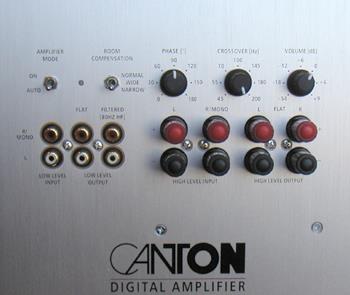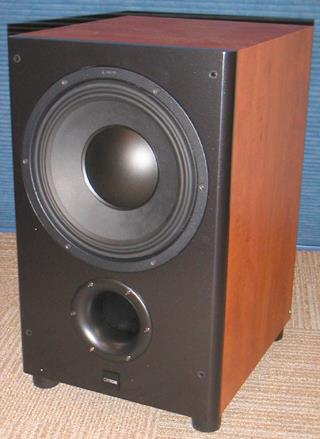
Introduction
The anchor of any action movie score is the thundering bass of jet engines,
explosions, and the like. Subwoofers perform the duty here.
But, most subwoofers today have to do double duty,
providing the impact of deep bass output in home theater settings without
sacrificing accuracy in music reproduction.
I had the opportunity to
evaluate Canton's AS 120 SC subwoofer for this review. While less well known
here in North America, Canton is the leading loudspeaker manufacturer in
Germany and their motto of "Pure Music" has been established during a design
history which extends over 30 years.
Features
The AS 120 SC is a ported box design, with a 12" forward firing
woofer and plate amp mounted on the rear (more on this below).
The AS 120
SC benefits from a number of design improvements in the Canton's Karat and
Vento loudspeaker lines, which have their own subwoofer models. The 12"
driver is made of a cellulose-graphite composite and features a sinusoidal
(double wave) surround, which increases the surround's excursion limits.
Canton claims the overall result of these design points is a more powerful,
yet more linear frequency response, particularly in deep bass.
The AS 120 SC is powered by a 200W digital switching amplifier
(Class D) based on ICEpower™
technology. ICEpower is a digital amplification platform that has been
jointly developed by the inventor, Karsten Nielsen, and Bang & Olufsen in
Denmark. You can learn more about ICEpower on their website (www.icepower.bang-olufsen.com) ,
which includes technical papers published through the Audio Engineering
Society (AES).
,
which includes technical papers published through the Audio Engineering
Society (AES).
The technology has only recently become available in
commercial products ranging from subwoofers (Canton, B&W) to active speakers
(Bang & Olufsen, Focal), to amplifiers (PS Audio, Rotel, Jeff Rowland).
Proponents of ICEpower point to the potential for amplification with the
fidelity of the best analog audio and the efficiency that digital amps have
always promised. It will be interesting to see in the coming years if
ICEpower systems fulfill this pledge.
Set-up
Upon removing the AS 120 from its shipping carton, I went about setting it
up in my home theater. Weighing in at 51 pounds, it's heavy but still fairly
straightforward to move about on your own. The unit I reviewed featured an
attractive cherry vinyl veneer, with a black front baffle and removable metal
grille cover which is fastened with pins and sockets at all four
 corners.
corners.
This sub isn't of the "hide behind the plant" variety, being roughly twice
the volume of the small Velodyne SPL-10 subwoofer in my casual living room
setup, but it's about half the size of my reference SVS CS-Plus in the home
theater.
There are large rubber feet to support the AS 120, which can also
be fitted with included metal spikes for carpeted surfaces. The owner's
manual included photographs to illustrate the set-up process and controls,
which were helpful.
The three prong IEC power cord is of the removable variety for those so
inclined, though I found the fit of the provided cable to be rather loose. I
connected the subwoofer's line-level input to my surround processor's sub output with an RCA
cable.
There is no setting to defeat the variable
crossover, so I adjusted the knob to the highest setting (200 Hz) as the manual
suggested. I also tried using a full-range output and employing the sub's
crossover at 80 Hz (where my processor is set) and could not discern an
audible difference.
The large flared port is situated on the front baffle,
below the driver. At the highest volumes during passages with deep bass
(Blade II "Jared Enters Stairwell" is a good test of this for subwoofers),
there was some port chuffing audible at the main seating position, which was
a little over 10' from the final placement of the AS 120. In general though,
the chuffing was not noticeable with most material at modest volume levels.
 The
instruction manual recommends placement somewhere in between the front L/R
speakers. My SVS subwoofer (cylindrical, downward firing woofer), is
normally situated near a front corner of my home theater room, but I tried
Canton's suggestion as a start.
The
instruction manual recommends placement somewhere in between the front L/R
speakers. My SVS subwoofer (cylindrical, downward firing woofer), is
normally situated near a front corner of my home theater room, but I tried
Canton's suggestion as a start.
I noticed the characteristic boominess of
room mode gain, even after experimenting with several locations (front,
corner, side). At this point I decided to employ the AS 120's room
compensation circuit. While not a full-blown parametric EQ or
auto-calibration system, this simple circuit has three settings (Wide,
Normal, Narrow) which vary the crossover slope. Essentially the control
alters deep bass extension and the slope and frequency of the high pass
filter in conjunction. While room modes are a function of the layout and
size of the physical space and can only truly be corrected by employing bass
traps or a multi-band parametric EQ, the AS 120's circuit can be helpful in
compensating for some level of room gain.
In my home theater room (approx 22
x 14 x 8, open on one side and without acoustical treatments), I found the
Narrow setting to provide the best compromise of deep bass (Narrow decreases
extension slightly) and more tamed room modes. With the aid of my simple but
trusty Radio Shack SPL meter, I got my levels set and was ready for the fun
part.
Click Here to Go to Part II.